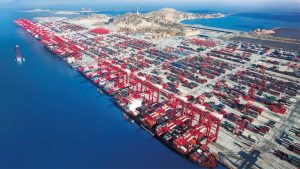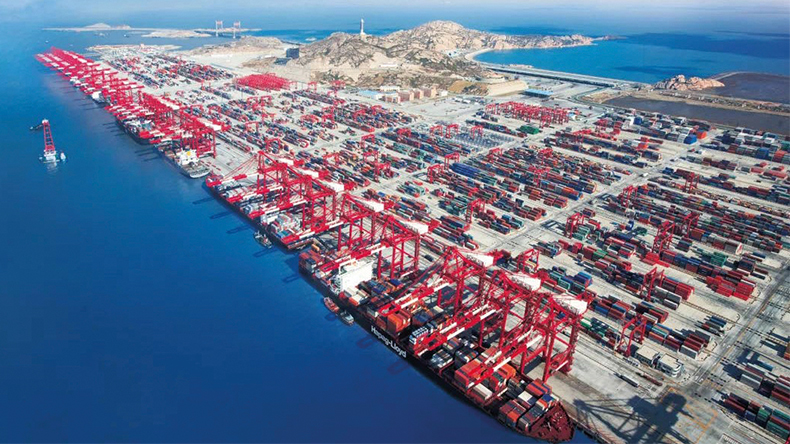
Shanghai Port in China has not only reaffirmed its status as the world’s premier container port but has also shattered global records, becoming the first port ever to handle over 50 million twenty-foot equivalent units (TEUs) in a single year. This landmark achievement in 2024 marks its 15th consecutive year as the world’s busiest container port, a testament to its critical role in powering global trade and the resilience of supply chains connecting Asian manufacturers to global markets.
The port’s growth momentum has continued unabated into 2025. During the first half of the year, Shanghai reported a container throughput of 27.065 million TEUs, representing a significant 6.1% year-on-year increase. The Yangshan Deep-Water Port area, the port’s automated crown jewel, was a major contributor to this growth, handling 14.056 million TEUs in H1 2025—accounting for over half of the port’s total container volume and demonstrating the success of its massive automation investments.
Record-Breaking Performance and Sustained Growth
Shanghai’s 2024 milestone of 51.51 million TEUs represents more than a statistical victory—it underscores the massive scale and efficiency required by modern global supply chains. This achievement is part of a long-standing growth trend for the port, which has consistently broken its own records despite global economic uncertainties and shifting trade patterns.
The port’s performance serves as a key indicator of economic health, with the record throughput in early 2025 reflecting robust foreign trade activity. The scale of operations is staggering, with the daily import and export value of goods handled averaging approximately 29.8 billion yuan, translating to roughly 1.24 billion yuan worth of goods processed every single hour.
Engineering Marvel and Technological Prowess
Shanghai’s dominance is underpinned by its world-class infrastructure, most notably the Yangshan Deep-Water Port. Linked to the mainland by the iconic Donghai Bridge, this facility represents the pinnacle of maritime engineering and is specifically designed to handle the latest generation of ultra-large container vessels that dominate main shipping routes.
The technological advancement at Yangshan is revolutionary:
-
The Yangshan Phase IV terminal operates as a fully automated facility using an intelligent control system that has significantly reduced reliance on foreign port software technology.
-
This automation has dramatically transformed operations, reducing workforce requirements by approximately 70% while simultaneously increasing overall efficiency by 30%.
-
The port’s massive facilities include 43 container terminals, 191 berths, and 156 container cranes, all engineered to handle a diverse range of cargo types with maximum efficiency.
The Heart of Global Trade Networks
Shanghai Port functions as a critical nexus for international commerce, with an influence that spans the globe. Its strategic location at the mouth of the Yangtze River provides direct access to China’s industrial heartland, while its deep-water capabilities accommodate the largest container vessels afloat.
The port’s connectivity is unmatched in the maritime world, served by nearly 350 international shipping services that connect to over 700 ports across more than 200 countries and regions. This extensive network has earned Shanghai the top position in global port connectivity rankings for 13 consecutive years, reinforcing its status as an indispensable node in global supply chains.
The port’s role as a transshipment hub is particularly noteworthy, with approximately 60% of its 2024 volume consisting of international transfer cargo. This highlights its enhanced function as a global hub where cargo is consolidated and redirected to its final destinations, making it a crucial interchange point for global trade flows.
Pioneering a Sustainable and Green Future
In tandem with its growth, Shanghai Port is making significant strides in reducing its environmental footprint and leading the industry’s green transition. The port has emerged as a pioneer in sustainable port operations, implementing comprehensive environmental initiatives that set new standards for the global maritime industry.
The port has established green shipping corridors through agreements with major international ports including Los Angeles and Hamburg, creating lower-emission routes across the globe. These corridors represent a concerted effort to reduce the carbon footprint of maritime trade while maintaining efficient cargo movement.
In a landmark achievement, Shanghai successfully completed its first ship-to-ship synchronous green methanol fueling operation for large container ships, positioning itself at the forefront of alternative marine fuel infrastructure. The port has set ambitious “double 100” goals for 2030, targeting LNG fueling capacity of one million cubic meters and green methanol and biofuels fueling capacity of one million tonnes, effectively transforming itself into a comprehensive “green energy fueling center” for the shipping industry.
Financial Health and Future Outlook
The operational success of Shanghai Port is mirrored in the strong financial performance of its operator, the Shanghai International Port Group (SIPG). The company has demonstrated robust financial health, with substantial revenue growth and profitability that reflects the port’s strategic importance and operational efficiency.
SIPG’s performance is closely tied to macroeconomic conditions and the demand for imported and exported goods, which are directly linked to the economic development of its vast hinterland. Looking ahead, the company acknowledges the container shipping market is in a “fragile balance” but is preparing for long-term trends, including vessel enlargement, digitalization, intelligence, green transformation, and the expansion of end-to-end logistics services.
The port’s continuous innovation and adaptation to changing market conditions suggest it will maintain its leadership position despite increasing competition from other Asian hubs and evolving global trade patterns.
An Enduring Global Powerhouse
Shanghai’s record-breaking performance and continued investment in technology and sustainability set a new benchmark for global maritime logistics. Its unprecedented scale, combined with its commitment to innovation and efficiency, ensures its role as a vital connector between Eastern and Western markets for the foreseeable future.
As the port continues to evolve, it will remain an indispensable artery for the global economy and a testament to the power of modern engineering and logistics. The story of Shanghai Port is not just about moving containers—it’s about connecting economies, enabling global commerce, and pioneering the future of maritime trade through technological innovation and sustainable practices.

